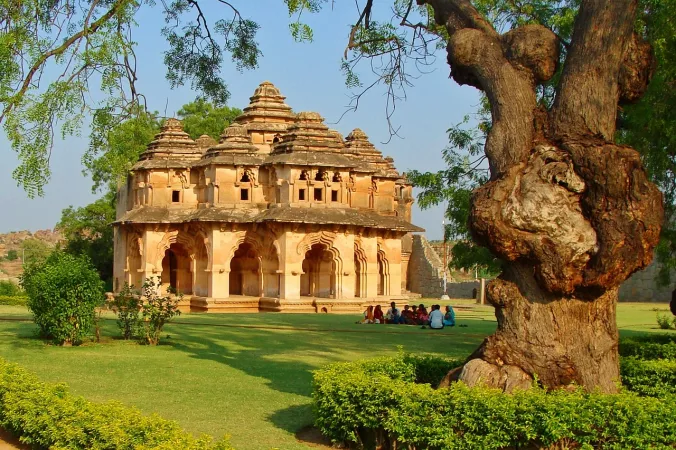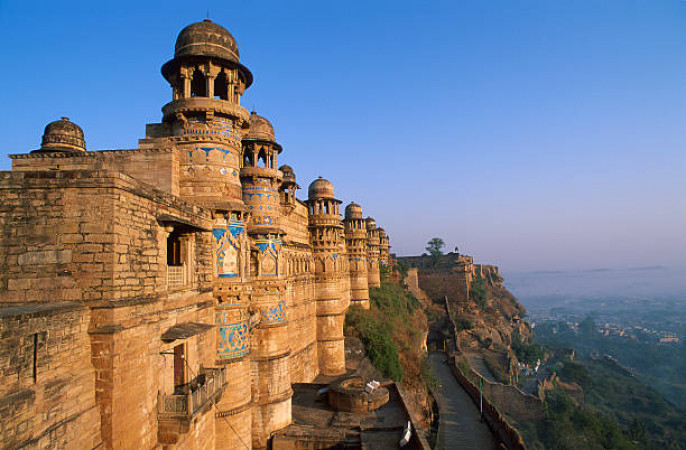
Mandu
Package
5999 to 9999
5999 to 9999
Duration
2 to 3 Days
2 to 3 Days
Best time to visit
Oct-Mar
Oct-Mar
Theme
Heritage
Heritage
Mandu Travel Guide
Mandu, also known as Mandavgad, is a picturesque town located in the Malwa region of Madhya Pradesh, India. This historical destination is famous for its architectural marvels, rich cultural heritage, and stunning natural beauty. With a history dating back to the 6th century, Mandu has been ruled by various dynasties, including the Paramaras, the Ghurids, and the Mughals, each leaving behind their unique imprint on the town. The town is perched on a rocky outcrop, offering panoramic views of the surrounding landscape.Top Attractions in Mandu
1. Jahaz Mahal 2. Rupmati Pavilion 3. Hoshang Shah's Tomb 4. Jami Masjid 5. Baz Bahadur's PalaceMandu is Famous for
Its magnificent Afghan architecture and romantic legends surrounding Baz Bahadur and Rupmati.Top Attractions in Mandu
- Jahaz Mahal - Rupmati Pavilion - Hoshang Shah's Tomb - Jami Masjid - Baz Bahadur's PalaceWhat's Great about Travelling to Mandu?
- History buffs will love exploring the ancient ruins and monuments. - Nature enthusiasts can enjoy the scenic beauty and tranquil atmosphere. - Photographers will find plenty of opportunities to capture stunning shots.What's Not So Great about Travelling to Mandu?
- Limited dining and accommodation options compared to larger cities. - The town may not be easily accessible for travelers with mobility issues.Travel Tips for Mandu
- Carry sufficient cash as ATMs may be limited. - Respect local customs and dress modestly when visiting religious sites. - Hire a local guide to learn more about the history and significance of the attractions.Important Mandu trip information
- Ideal Duration: Spend 2-3 days to explore Mandu thoroughly.
- Best Time to Visit: Visit between October and March for pleasant weather.
- Nearby Airports and Railway Stations: The nearest airport is Indore Airport, and the closest railway station is Indore Junction.
Top 10 Places to visit in Mandu
FAQ's on Mandu
Q1: What is the best time to visit Mandu?
The best time to visit Mandu is during the winter months from October to March when the weather is pleasant and ideal for exploring the historical sites. Avoid the summer months from April to June as it can get very hot. The monsoon season from July to September brings lush greenery but also heavy rainfall, which may affect travel plans.
Q2: Do I need a visa to travel to Mandu?
Most tourists visiting Mandu will need a tourist visa to enter the country. Visa requirements may vary depending on your nationality, so it's advisable to check with the nearest embassy or consulate. Some countries may have visa exemptions or visa-on-arrival facilities. Make sure your passport is valid for at least six months beyond your intended stay.
Q3: What are the must-visit attractions in Mandu?
Mandu is home to stunning historical sites such as the Jahaz Mahal, Hindola Mahal, Rupmati's Pavilion, and the intricately designed Baz Bahadur's Palace. The Mandu Fort, with its breathtaking views, and the Jami Masjid, a magnificent mosque, are also must-visit attractions. Don't miss exploring the romantic stories of Baz Bahadur and Rupmati at Roopmati's Pavilion while enjoying panoramic views of the Narmada River.
Q4: Is Mandu a safe place to travel?
Mandu is generally a safe destination for travelers. However, like any other place, it's advisable to take basic precautions such as safeguarding your belongings, avoiding isolated areas at night, and respecting local customs. While petty crime can occur, overall, Mandu is considered safe for tourists. It's recommended to stay informed about local news and follow any travel advisories issued by your government.
Q5: What is the local currency in Mandu and can I use credit cards?
The local currency in Mandu is the Indian Rupee (INR). ATMs are available in major cities, but it's advisable to carry cash when visiting remote areas. Credit cards are widely accepted in hotels, restaurants, and larger stores, but smaller establishments may prefer cash. Notify your bank before traveling to avoid any issues with card transactions and currency conversion fees.
Q6: What is the local cuisine like in Mandu?
Mandu offers a rich culinary experience with a variety of traditional dishes. Don't miss trying the local specialties like Poha, Dal Bafla, Bhutte ka Kees, and the famous street food delicacy, Garadu. Savor the flavors of Malwa cuisine which includes a mix of spicy, sweet, and tangy dishes. Vegetarian options are prevalent, but you can also find non-vegetarian dishes like Kebabs and Biryani. Be prepared for the use of aromatic spices that add a unique taste to the dishes.
Q7: What transportation options are available in Mandu?
In Mandu, transportation options include buses, taxis, auto-rickshaws, and rental cars. Local buses are a cost-effective way to travel within the city and to nearby attractions. Taxis and auto-rickshaws are convenient for short distances, while rental cars provide flexibility for exploring Mandu at your own pace. Hiring a guide or joining a tour can also be a great way to navigate the historical sites and learn about the region's rich history.
Q8: Are there any cultural norms or etiquette I should be aware of when visiting Mandu?
When visiting Mandu, it's important to respect local customs and traditions. Dress modestly, especially when visiting religious sites, and remove your shoes before entering temples or mosques. Greet people with a warm "Namaste" and seek permission before taking photographs of locals. Avoid public displays of affection and be mindful of your behavior in public spaces. It's customary to tip service staff in restaurants and hotels, but not mandatory. Embrace the cultural diversity of Mandu with an open mind and show appreciation for the heritage and hospitality of the locals.
Q9: I am a travel agent. How can I buy travel leads of Mandu?
Register yourself as a travel agent at agents.tripclap.com and then you can buy travel leads to Mandu once your account is approved. For more details contact our support team at +91-8069186564 or support@tripclap.com







